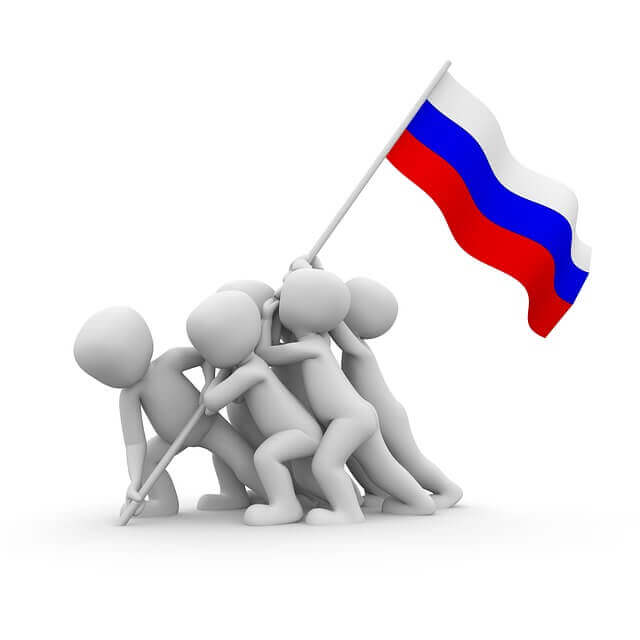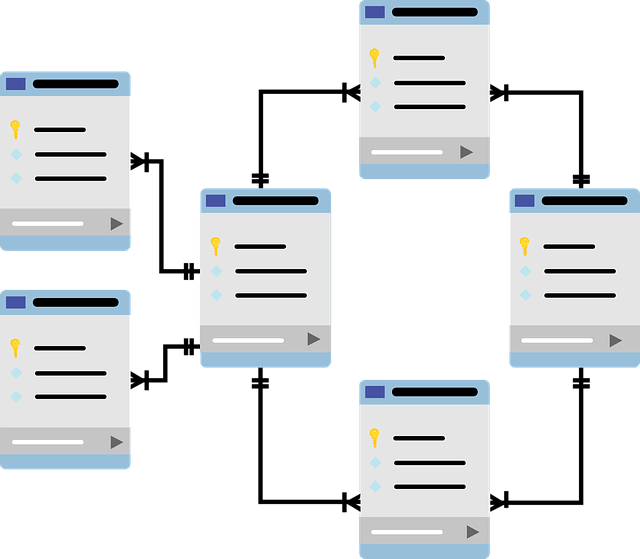Введение
Планирование расхода электроэнергии на технологические цели в электросталеплавильном производстве металлургического предприятия является одной из составляющих расчета потребности предприятия в оборотных средствах. От того насколько точно произведены расчеты зависит величина затрат на привлечение заемного капитала для ведения хозяйственной деятельности, а также размер потерь от резервирования избыточного запаса денежных средств.
Исследованию вопросов расчета электропотребления оборудованием промышленных предприятий посвящены работы таких авторов, как С.П. Агеев [1], А.М. Вдовин [4], Н.Б. Дьячков [5], А.Е. Желудков [6], Е.З. Зайцев [7], Б.И. Кудрин [11, 13], Г.В. Никифоров и др. [15], С.А. Петрицкий [16], Д.В. Шуралев [20], М.В. Янюшкин [21]. Проблемы планирования расхода электроэнергии в электросталеплавильных цехах (ЭСПЦ) металлургических предприятий изучены в работах Е.С. Катайцевой [9], Б.И. Кудрина [12], В.Ш. Трофимовой и А.В. Липатникова [18], С.А. Хорькова [19].
Анализ литературных источников позволяет заключить, что в настоящее время сформировалось два основных подхода к расчету потребного количества электроэнергии, расходуемой промышленным оборудованием, в том числе и агрегатами ЭСПЦ (Электросталеплавильный цех) [10]:
- первый подход основан на использовании регрессионной зависимости расхода электроэнергии от значимых факторов производственного процесса;
- второй подход — на использовании вероятностного распределения расхода электроэнергии, то есть на представлении расхода электроэнергии как результата воздействия большого числа случайных факторов.
Следует отметить, что первый подход целесообразно использовать в случае достаточной адекватности регрессионных моделей, второй – в обратной ситуации.
Фактическая методика планировании расхода электроэнергии в электросталеплавильном цехе металлургического предприятия
В настоящее время на площадке железнодорожного проката металлургического предприятия при планировании расхода электроэнергии используется методика, разработанная доктором технических наук, профессором Московского энергетического института Б. И. Кудриным, основанная на применении простой степенной регрессионной зависимости вида:
 , (1)
, (1)
где Y – удельный расход электрической энергии, кВт∙ч/т;
X – среднесуточное производство стали (в календарные сутки) по электропечам за месяц, т;
A, B – параметры регрессии, определяемые эмпирическим путем по каждой группе потребителей электрической энергии.
Оценка параметров уравнения степенной регрессии, согласно методике [14], осуществляется на предприятии отдельно по каждому технологическому агрегату, участвующему в процессе получения и обработки стали в ЭСПЦ: первой и второй дуговым 110 тонным сталеплавильным печам (ДСП1 и ДСП2), двум машинам непрерывного литья заготовки (МНЛЗ), первому и второму агрегатам комплексной обработки стали (АКОС1 и АКОС2), вакууматору и прочему оборудованию. Для снижения влияния на значения параметров регрессии такого фактора, как среднемесячная температура воздуха, оценка уравнений регрессии производится на предприятии отдельно для летнего и зимнего периодов года. К летнему периоду года относят месяцы с апреля по сентябрь, к зимнему – все остальные месяцы года. Значения удельного расхода электроэнергии, существенно отклоняющиеся от среднего значения (более 15%), в соответствии с принятой методикой, из объема выборки при оценке модели исключаются.
На основании полученных степенных уравнений регрессии первоначально осуществляется прогноз среднемесячного значения удельного расхода электроэнергии на соответствующий период будущего года по каждому технологическому агрегату ЭСПЦ, а затем определяется общий плановый удельный расход электроэнергии на технологические цели по цеху путем суммирования плановых значений этого показателя по технологическим агрегатам.
Таким образом, в условиях ЭСПЦ металлургического предприятия реализуется первый, из выделенных ранее подходов к расчету планового расхода электроэнергии на технологические цели.
Однако использование среднесуточного объема производства стали в качестве единственной экзогенной переменной имеет как положительные, так и отрицательные черты. С одной стороны, учет влияния одного фактора снижает трудоемкость планирования. Кроме того, среднесуточный объем производства стали, являясь показателем работы оборудования, производным от первичных технологических факторов, таких как длительность и масса электросталеплавильной плавки, величина горячего резерва, доля чугуна в завалке и т.п., выражает комплексное влияние этих технологических факторов на расход электроэнергии. Однако, с другой стороны, если влияние отдельных из таких факторов на расход электроэнергии незначимо, то опосредованный учет данного влияния через показатель объема производства стали приведет к снижению статистической значимости модели, а возможно, и к уменьшению ее адекватности.
Кроме того, фактически применяемая на комбинате методика предполагает наличие значимого влияния на расход технологической электроэнергии среднемесячной температуры воздуха. Такой подход в свою очередь снижает объемы выборок, используемых для построения регрессионных моделей, а, следовательно, и значимость этих моделей.
Оценка точности фактической методики планирования
Для определения возможных направлений повышения качества планирования расхода электроэнергии на технологические цели в ЭСПЦ металлургического предприятия нами на первом этапе исследования была проведена оценка точности фактической методики планирования.
Для выполнения данного этапа исследования использовались средства статистического пакета STATISTICA. Оценка параметров модели степенной регрессии (1) осуществлялась по основным агрегатам ЭСПЦ (ДСП1, ДСП2, АКОС, МНЛЗ, вакууматору) по данным за 2012 год (представлены в таблице 1). Отметим, что в цехе установлены две МНЛЗ, однако в связи с тем, что учет расхода электроэнергии по этим агрегатам не разделен, оценка регрессии проводилась по участку разливки стали в целом. Кроме того, на участке АКОС также установлены два агрегата, учет электрической энергии по которым осуществляется раздельно, а планирование производства стали – совместно. В связи с этим по участку АКОС, также, как и по участку МНЛЗ, оценка регрессии проводилась без дифференциации по агрегатам. Так как процессу вакуумации в цехе подвергается только рельсовая сталь, то в качестве экзогенной переменной в моделях регрессии по вакууматору выступал среднесуточный объем производства рельсовой стали. Прогноз удельного расхода электроэнергии и оценка его точности осуществлялись по данным экзаменационной выборки 2013 года (представлены в таблице 2). Для исключения влияния на оценку качества прогноза расхода электроэнергии по модели точности планирования экзогенного фактора– среднесуточного объема производства стали, его значение принималось на уровне фактического.
Диаграммы рассеяния данных для основных агрегатов ЭСПЦ с нанесением теоретических кривых представлены на рис. 1, 2. Отметим, что при построении моделей зимнего периода были исключены данные за октябрь 2012 года, так как в этом месяце после окончания капитального ремонта ДСП2 была проведена лишь одна тестовая плавка.
Результаты оценки значимости степенных моделей зимнего и летнего периодов, полученных при использовании фактической методики прогнозирования расходов электроэнергии в электросталеплавильном цехе предприятия, приведены в таблице 3. Оценка точности прогноза, полученного при использовании фактической методики, производилась с помощью показателя относительной ошибки прогноза, результаты расчетов которой представлены в таблице 4. Отметим, что оценка модели степенной регрессии по ДСП1 в летнем периоде не производилась в связи с наличием производства по данному агрегату только в течение одного летнего месяца 2012 года (апреля).
Таблица 1 – Исходные данные за 2012 год для оценки модели степенной регрессии по основным агрегатам ЭСПЦ

Примечание: X – среднесуточный объем производства стали (в календарные сутки), т; Y – удельный расход электроэнергии, кВт∙ч/т.
Таблица 2 – Данные экзаменационной выборки за 2013 год

Примечание: X – среднесуточный объем производства стали (в календарные сутки), т; Y – удельный расход электроэнергии, кВт∙ч/т.
а) 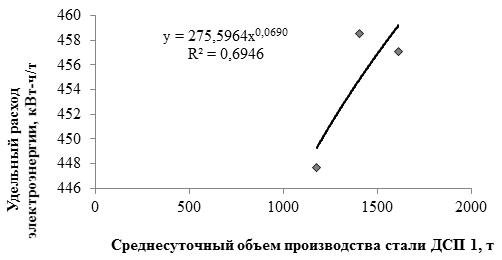
б) 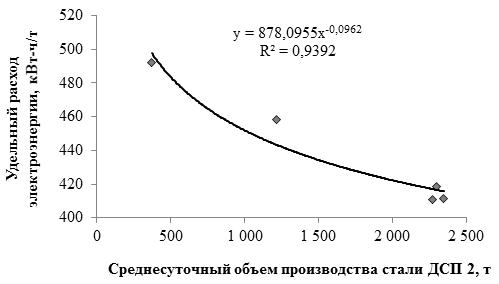
в) 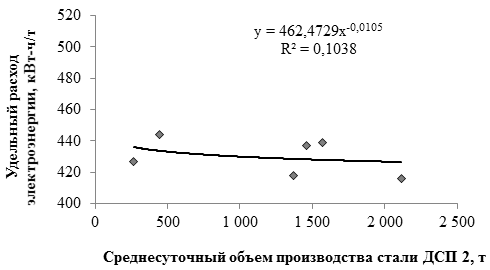
Рис. 1. Зависимость удельного расхода электроэнергии по ДСП1 и ДСП2 от среднесуточного объема производства стали по данным 2012 года: а) зимний период (ДСП1); б) зимний период (ДСП2); в) летний период (ДСП2)
а) 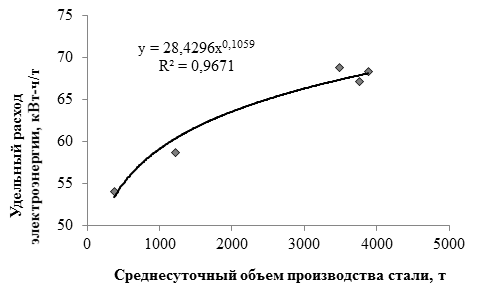
б) 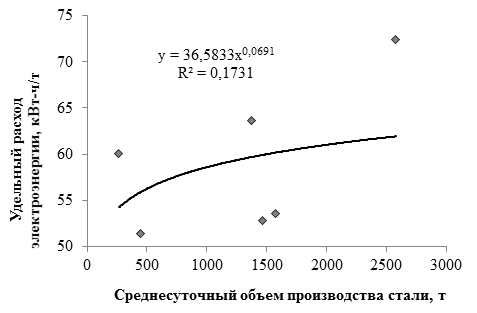
Рис. 2. Зависимость удельного расхода электроэнергии по АКОС от среднесуточного объема производства стали по данным 2012 года: а) зимний период; б) летний период
а) 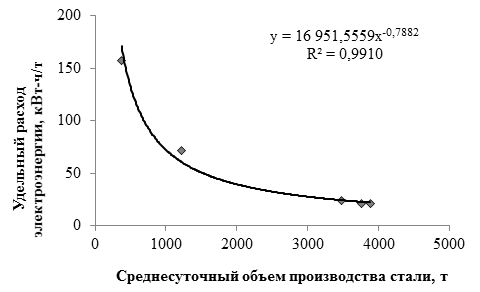
б) 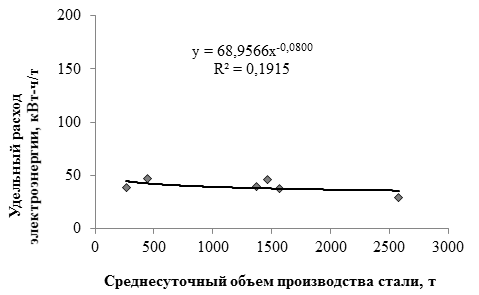
Рис. 3. Зависимость удельного расхода электроэнергии по МНЛЗ от среднесуточного объема производства стали по данным 2012 года: а) зимний период; б) летний период
а) 
б) 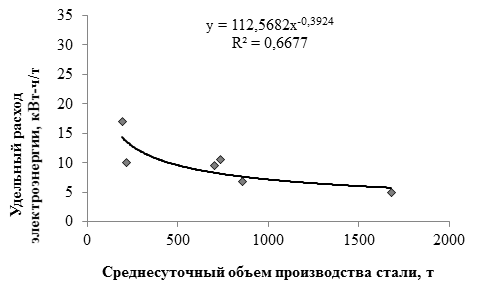
Рис. 4. Зависимость удельного расхода электроэнергии по вакууматору от среднесуточного объема производства стали по данным 2012 года: а) зимний период; б) летний период
Таблица 3 – Оценка значимости моделей степенной регрессии, полученных при использовании фактической методики прогнозирования удельных расходов электроэнергии по агрегатам ЭСПЦ по данным за 2012 год
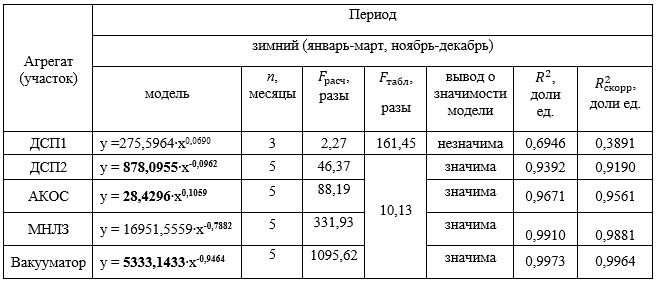
Продолжение таблицы 3
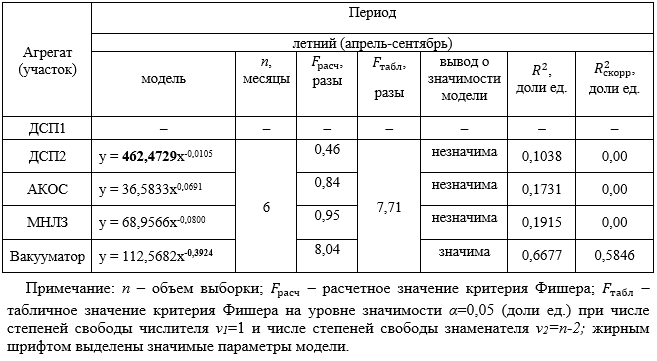
Таблица 4 – Оценка точности фактической методики планирования удельного расхода электроэнергии по агрегатам ЭСПЦ по данным 2013 года
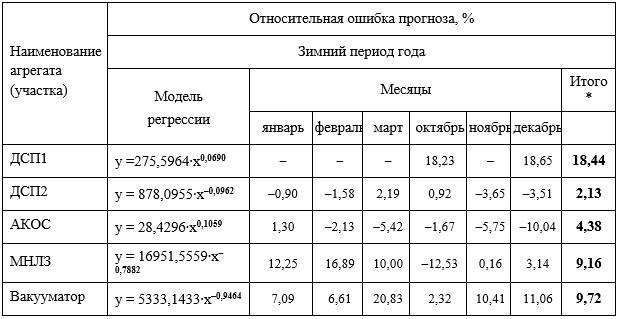
Продолжение таблицы 4
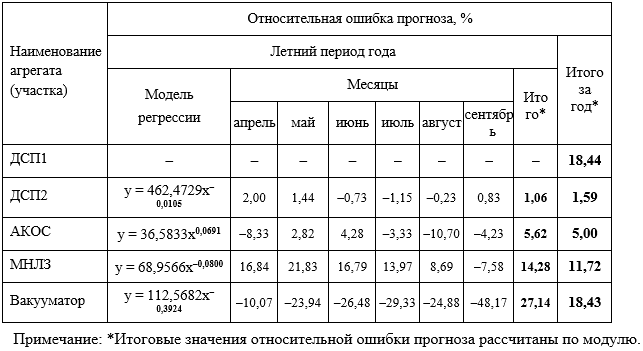
Как следует из представленных в таблице 3 сведений, все модели зимнего периода (за исключением модели для ДСП1) характеризуются высокой значимостью; напротив, среди моделей летнего периода, несмотря на увеличение объема выборки, значима только модель прогноза расхода электроэнергии для вакууматора.
По таким агрегатам, как ДСП2, МНЛЗ и вакууматор, наблюдается обратная зависимость удельного расхода электроэнергии от среднесуточного объема производства стали и низкая степень вариации удельного расхода электроэнергии относительно среднего значения (равна коэффициенту B модели регрессии и колеблется по перечисленным агрегатам от –0,1 до –0,9 %/%). Напротив, по АКОС наблюдается прямая зависимость: чем больший объем стали проходит в среднем за сутки комплексную обработку, тем больше удельный расход электроэнергии. Такое направление зависимости объясняется повышением трудоемкости усреднения химического состава стали с ростом объема ее обработки.
Учитывая, что модель зимнего периода для ДСП1 построена всего по трем наблюдениям и является статистически незначимой по критерию Фишера, на основании значения ее коэффициента B нельзя строить достоверные выводы о направлении зависимости между среднесуточным объемом производства стали и удельным расходом электроэнергии.
Значительно более низкая адекватность моделей летнего периода по сравнению с зимним может свидетельствовать, во-первых, об отсутствии существенной зависимости удельного расхода электроэнергии от времени года, а во-вторых, о наличии не включенных в модель значимых факторов, влияющих на удельный расход электроэнергии.
Модели зимнего периода характеризуются значительно более высокой адекватностью по сравнению с моделями летнего периода по всем агрегатам (90 % против 10÷60 %). Вместе с тем точность прогноза по моделям летнего периода (см. таблицу 4) находится на уровне близком к точности прогноза по моделям зимнего периода (5÷20 %). Более того, по такому основному агрегату как ДСП2, ошибка прогноза по модели летнего периода не превышает 1 %, что меньше аналогичного значения для зимнего периода (2 %). Этот факт может объясняться недостаточной статистической значимостью полученных моделей, что в свою очередь обусловлено малым объемом выборки, использованным для их построения. Таким образом, одним из направлений совершенствования рассматриваемой методики является повышение статистической значимости моделей и, как следствие, повышение соответствия между адекватностью моделей и точностью прогноза по ним. Это может быть достигнуто за счет перехода от анализа средних за месяц объемов производства стали и удельного расхода электроэнергии к построению моделей на основании суточных данных каждого месяца года. Кроме того, несоответствие ожидаемой (на основании высокой адекватности) и фактической точности статистически значимых моделей зимнего периода свидетельствует о качественном изменении характера зависимости удельного расхода электроэнергии и ставит задачу поиска альтернативных моделей зависимости от других факторов.
Наименьшая ошибка прогноза как в целом, так и по летнему и зимнему периодам года, наблюдается по ДСП2, наибольшие значения ошибки прогноза соответствуют таким агрегатам, как МНЛЗ и вакууматор.
На основании прогноза удельного расхода электроэнергии по фактической методике был произведен расчет отклонений общего фактического расхода электроэнергии по основным агрегатам ЭСПЦ (по данным 2013 года) от плановых значений (результаты представлены в таблице 5), а также оценка потерь предприятия, обусловленных качеством планирования.
Таблица 5 – Абсолютная ошибка прогноза общего расхода электроэнергии по основным агрегатам ЭСПЦ на 2013 год при использовании фактической методики

Экономическая оценки потерь предприятия, обусловленных качеством планирования расхода электроэнергии
Вопросы экономической оценки издержек предприятия, связанных с качеством планирования расхода электроэнергии в современных условиях, рассмотрены в работах П.В. Валь, Ю.П. Попова [3] и В.Ш. Трофимовой, А.В. Липатникова [18]. Как известно, в настоящее время расходы предприятия, связанные с приобретением электроэнергии, зависят от максимальной мощности энергопринимающих устройств и выбранной в соответствии с ней ценовой категории [8]. Четвертая ценовая категория, которая выбрана АО «ЗСМК», предусматривает оплату услуг по передаче электроэнергии по двухставочному тарифу и при этом не требует ведения почасового планирования потребления электроэнергии. Ежемесячные потери предприятия (П), связанные с качеством планирования расхода электроэнергии в этой ценовой категории, включают три составляющие [3]:
- потери, связанные с продажей избытка заказанной электроэнергии по сниженным ценам (П1);
- потери, связанные с покупкой сверхпланового количества электроэнергии по повышенным ценам (П2);
- потери, обусловленные оплатой части отрицательного небаланса ОРЭМ соответствующей ценовой зоны (П3).
Образование потерь первого и второго вида обусловлено тем фактом, что при продаже избытка электроэнергии на балансирующем рынке (БР) или приобретении его недостающего количества цена продажи или покупки за отдельный час суток определяется исходя из наименее выгодных для предприятия условий:

где j – номер часа суток;
ЦРСВj – цена на электроэнергию на рынке на сутки вперед (РСВ) за j-й час суток (соответствует плановой цене продажи или покупки электроэнергии), руб./Мвт-ч;
ЦБРj – цена на электроэнергию на балансирующем рынке (БР) за j-й час суток, руб./Мвт-ч.
Таким образом, часовые потери предприятия при продаже избытка электроэнергии за j-й час суток (П1j) или при приобретении сверхпланового количества электроэнергии за j-й час суток (П2j) определятся по формулам:
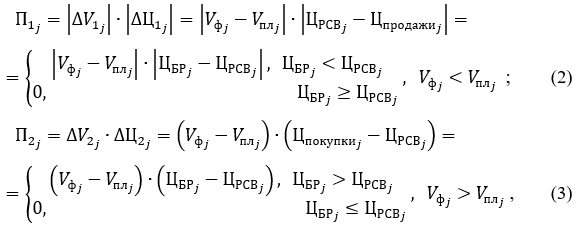
где  – избыток электроэнергии за j-й час суток, наблюдающийся при превышении планового (прогнозного) потребления электроэнергии предприятием (агрегатом) за j–й час суток по сравнению с фактическим потреблением, Мвт-ч;
– избыток электроэнергии за j-й час суток, наблюдающийся при превышении планового (прогнозного) потребления электроэнергии предприятием (агрегатом) за j–й час суток по сравнению с фактическим потреблением, Мвт-ч;
 – абсолютная величина снижения цены продажи избытка электроэнергии на балансирующем рынке по сравнению с ценой ее приобретения на рынке на сутки вперед за j-й час суток, руб./Мвт-ч;
– абсолютная величина снижения цены продажи избытка электроэнергии на балансирующем рынке по сравнению с ценой ее приобретения на рынке на сутки вперед за j-й час суток, руб./Мвт-ч;
 – недостаток электроэнергии за j-й час суток, наблюдающийся при превышении фактического потребления электроэнергии предприятием (агрегатом) за j–й час суток по сравнению с плановым (прогнозным) потреблением, Мвт-ч;
– недостаток электроэнергии за j-й час суток, наблюдающийся при превышении фактического потребления электроэнергии предприятием (агрегатом) за j–й час суток по сравнению с плановым (прогнозным) потреблением, Мвт-ч;
 – увеличение цены покупки электроэнергии на балансирующем рынке по сравнению с ценой ее приобретения на рынке на сутки вперед за j-й час суток, руб./Мвт-ч;
– увеличение цены покупки электроэнергии на балансирующем рынке по сравнению с ценой ее приобретения на рынке на сутки вперед за j-й час суток, руб./Мвт-ч;
 – соответственно фактическое и плановое потребление электроэнергии предприятием (агрегатом) за j-й час суток, Мвт-ч.
– соответственно фактическое и плановое потребление электроэнергии предприятием (агрегатом) за j-й час суток, Мвт-ч.
Ежемесячные потери, связанные с продажей избытка заказанной электроэнергии по сниженным ценам (П1) и с покупкой сверхпланового количества электроэнергии по повышенным ценам (П2), определяются путем суммирования часовых значений П1j и П2j соответственно по суткам месяца.
Однако, в связи с тем, что планирование расхода электроэнергии на предприятии, в том числе по агрегатам ЭСПЦ, осуществляется помесячно, и точные значения отклонений фактического часового потребления электроэнергии по агрегатам от планового не известны, непосредственное применение формул (2) и (3) для оценки потерь не представляется возможным, и ежемесячные значения потерь первого и второго вида можно оценить лишь приближенно. Так как металлургическое предприятие относится к предприятиям с трехсменным режимом работы, то для оценки ежемесячных потерь первого и второго вида, было принято предположение о равномерном распределении планового (прогнозного) объема производства стали в течение часов и суток месяца. В связи с отсутствием точной информации о распределении фактического объема производства по часам суток каждого месяца относительно него было принято аналогичное предположение. Тогда ежемесячные потери предприятия, связанные с продажей избытка заказанной электроэнергии по сниженным ценам (П1) и с покупкой сверхпланового количества электроэнергии по повышенным ценам (П2) приближенно определятся по формулам:

где  – избыток электроэнергии, заказанной за месяц (экономия электроэнергии в сравнении с планом), Мвт-ч;
– избыток электроэнергии, заказанной за месяц (экономия электроэнергии в сравнении с планом), Мвт-ч;
 – среднечасовая за месяц абсолютная величина снижения цены продажи избытка электроэнергии на балансирующем рынке по сравнению с ценой ее приобретения на рынке на сутки вперед, руб./Мвт-ч;
– среднечасовая за месяц абсолютная величина снижения цены продажи избытка электроэнергии на балансирующем рынке по сравнению с ценой ее приобретения на рынке на сутки вперед, руб./Мвт-ч;
 – средняя доля часов суток за месяц, в течение которых наблюдалось снижение цены продажи избытка электроэнергии на балансирующем рынке по сравнению с ценой ее приобретения на рынке на сутки вперед, доли ед.;
– средняя доля часов суток за месяц, в течение которых наблюдалось снижение цены продажи избытка электроэнергии на балансирующем рынке по сравнению с ценой ее приобретения на рынке на сутки вперед, доли ед.;
 – перерасход электроэнергии в сравнении с планом за месяц, Мвт-ч;
– перерасход электроэнергии в сравнении с планом за месяц, Мвт-ч;
 – среднечасовое за месяц увеличение цены покупки электроэнергии на балансирующем рынке по сравнению с ценой ее приобретения на рынке на сутки вперед, руб./Мвт-ч;
– среднечасовое за месяц увеличение цены покупки электроэнергии на балансирующем рынке по сравнению с ценой ее приобретения на рынке на сутки вперед, руб./Мвт-ч;
 – средняя доля часов суток за месяц, в течение которых наблюдалось увеличение цены покупки электроэнергии на балансирующем рынке по сравнению с ценой ее приобретения на рынке на сутки вперед, доли ед.
– средняя доля часов суток за месяц, в течение которых наблюдалось увеличение цены покупки электроэнергии на балансирующем рынке по сравнению с ценой ее приобретения на рынке на сутки вперед, доли ед.
Значения экономии и перерасхода электроэнергии по агрегатам предприятия за месяц по сравнению с плановыми значениями определялись по формулам:

где  – соответственно фактический и плановый расход электроэнергии по агрегату цеха за месяц, Мвт-ч.
– соответственно фактический и плановый расход электроэнергии по агрегату цеха за месяц, Мвт-ч.
Третья составляющая ежемесячных потерь предприятия, связанных с качеством планирования расхода электроэнергии, – потери, обусловленные оплатой части отрицательного небаланса ОРЭМ соответствующей ценовой зоны (П3), определяется по формуле [3]:
 ,
,
где  – совокупный объем всех отклонений фактического расхода электроэнергии предприятием от планового по собственной инициативе за отчетный период (месяц) (по абсолютному значению), кВт-ч;
– совокупный объем всех отклонений фактического расхода электроэнергии предприятием от планового по собственной инициативе за отчетный период (месяц) (по абсолютному значению), кВт-ч;
 – стоимость отклонения фактического расхода электроэнергии от планового по собственной инициативе в отчетном периоде (месяце) для предприятий соответствующей ценовой зоны, руб./кВт-ч.
– стоимость отклонения фактического расхода электроэнергии от планового по собственной инициативе в отчетном периоде (месяце) для предприятий соответствующей ценовой зоны, руб./кВт-ч.
Стоимость одного часа отклонения расхода электроэнергии по собственной инициативе предприятия определяется на ОРЭМ ежемесячно для каждой ценовой зоны в зависимости от суммарных обязательств и требований участников рынка [2]:
 ,
,
где Р – разность суммарных обязательств и суммарных требований участников ОРЭМ соответствующей ценовой зоны по покупке и продаже электроэнергии в отчетном периоде, руб.;
VСИ – совокупный объем всех составляющих величин отклонений (покупки и продажи электроэнергии) по собственной инициативе в данной ценовой зоне (по абсолютному значению), кВт-ч.
Результаты расчета потерь предприятия первого и второго вида на примере основного агрегата ЭСПЦ – ДСП2, представлены в таблице 6. Для выполнения расчета ценовые составляющие формул (4) и (5),  , определялись как средние значения по часам суток соответствующих месяцев путем сопоставления цены продажи избытка электроэнергии или цены приобретения недостающего количества электроэнергии на балансирующем рынке с ценой ее приобретения на рынке на сутки вперед. Для расчета использовались данные по ОЭС Сибири [2, 17]. На основании значений
, определялись как средние значения по часам суток соответствующих месяцев путем сопоставления цены продажи избытка электроэнергии или цены приобретения недостающего количества электроэнергии на балансирующем рынке с ценой ее приобретения на рынке на сутки вперед. Для расчета использовались данные по ОЭС Сибири [2, 17]. На основании значений  рассчитывались количество и доля часов суток за месяц с определенным соотношением цен балансирующего рынка и рынка на сутки вперед –
рассчитывались количество и доля часов суток за месяц с определенным соотношением цен балансирующего рынка и рынка на сутки вперед –  .
.
Расчет потерь предприятия третьего вида (таблица 7) осуществлялся на основании данных о фактическом и плановом расходе электроэнергии по агрегатам ЭСПЦ (см. таблицу 5) и сведениях о стоимости корректировки небаланса электрической энергии (мощности) между участниками ОРЭМ второй ценовой зоны (Сибирь) по месяцам 2013 года [2].
Итоговые результаты экономической оценки потерь предприятия, обусловленных качеством планирования расхода электроэнергии в ЭСПЦ (в ценах 2013 года), представлены в таблице 8.
Следует отметить, что отклонения фактического месячного расхода электроэнергии от планируемого по различным агрегатам цеха носят случайный характер. В связи с этим при определении суммарного результата по цеху положительные значения отклонений нивелируют отрицательные. При условии равномерного распределении фактического расхода электроэнергии по часам суток планируемого месяца максимально возможная компенсация потерь цеха за счет нивелирования положительных и отрицательных отклонений расхода электроэнергии от планового значения уменьшает общую величину цеховых потерь, обусловленных качеством планирования расхода технологической электроэнергии по отдельным агрегатам, практически на 50% (таблица 8).
Таблица 6 – Расчет потерь по ДСП 2, связанных с продажей избытка электроэнергии по сниженным ценам и покупкой сверхпланового количества электроэнергии по повышенным ценам
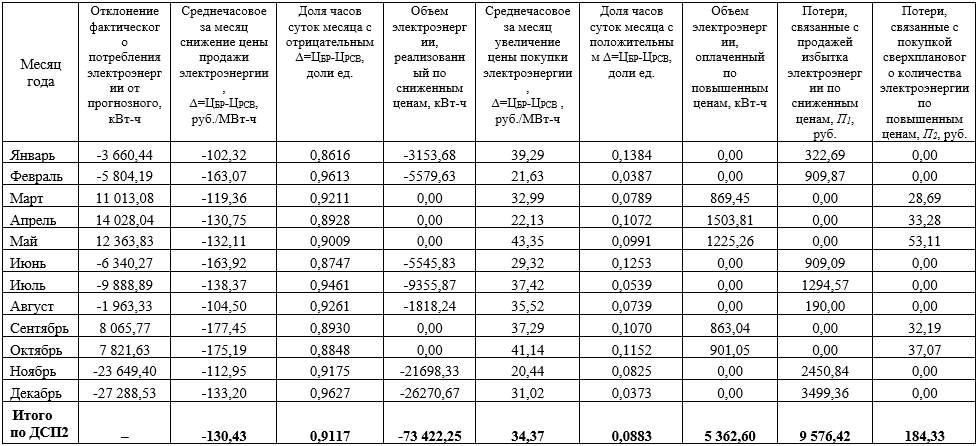
Таблица 7 – Годовые потери по ЭСПЦ в связи с оплатой отрицательного небаланса ОРЭМ

Таблица 8 – Годовые потери, обусловленные качеством планирования удельного расхода электроэнергии в ЭСПЦ
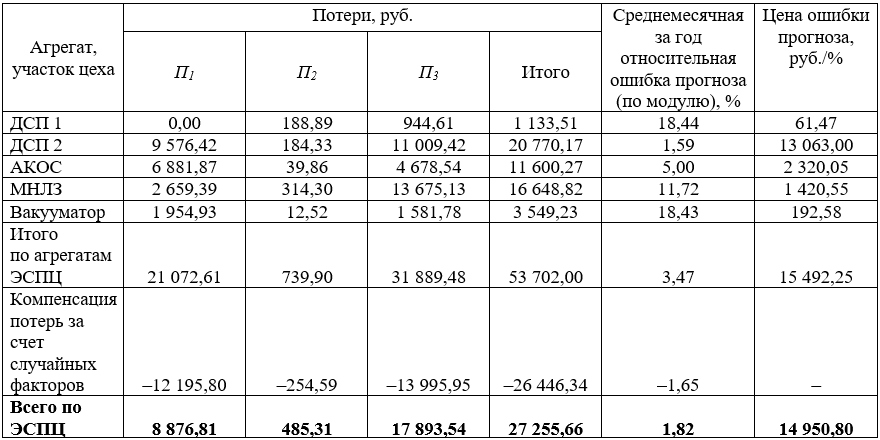
Фактическая методика, благодаря незначительным ошибкам прогноза по агрегатам, потребляющим основную долю электроэнергии (ДСП2 и АКОС), а также взаимной компенсации разнонаправленных колебаний расхода электроэнергии по агрегатам цеха, обеспечивает достаточно низкие годовые потери, не превышающие 28 тыс. руб. (в ценах 2013 года). Наибольшее влияние на их величину оказывают потери по ДСП2, существенное – потери по участкам МНЛЗ и АКОС. Первое обусловлено большими объемами выплавляемой стали на агрегате; потери же по участкам МНЛЗ и АКОС могут объясняться сводным планированием, не учитывающим особенности расхода электроэнергии по агрегатам участков. Наибольшая цена ошибки прогноза (13 тыс. руб./%) соответствует ДСП2, что свидетельствует об актуальности совершенствования методики планирования расхода электроэнергии по данному агрегату в первую очередь. Вместе с тем, влияние высокой ошибки прогноза удельного расхода электроэнергии по ДСП1 (18,44 %) и, как следствие, необходимость совершенствования методики прогнозирования по этому агрегату могут возрастать по мере увеличения загрузки ДСП1.
Кроме того, отметим, что с учетом среднего роста индекса равновесных цен на покупку электроэнергии по ОЭС Сибири за период с 2013 по 2016 год в размере 1,27 раза и роста стоимости корректировки отрицательного небаланса ОРЭМ в размере 2,38 раза [2, 17] потери предприятия, обусловленные качеством планирования расхода электроэнергии по основным агрегатам ЭСПЦ, в действующих ценах достигают уровня 55÷100 тыс.руб./год (в зависимости от степени компенсации за счет случайных факторов), а стоимость относительной ошибки прогноза в среднем по ЭСПЦ при аналогичном уровне загрузки производственных мощностей агрегатов – 30 тыс.руб. на 1 % за год.
Выводы
В работе выполнена оценка эффективности фактической методики планирования расхода электроэнергии на технологические нужды по основным агрегатам ЭСПЦ металлургического предприятия, основанной на использовании регрессионных моделей степенной зависимости от среднесуточного объема производства стали. Выявлена достаточно высокая точность прогноза наряду с сильной вариацией адекватности и статистической значимости моделей по периодам года, что может быть обусловлено как малым объемом выборок, используемых для анализа в соответствии с принятой в цехе методикой, так и влиянием на расход электроэнергии альтернативных факторов. Экономическая оценка потерь, связанных с качеством планирования расхода электроэнергии на технологические цели в ЭСПЦ, свидетельствует о необходимости первоочередного совершенствования методики планирования расхода электроэнергии по таким агрегатам цеха, как ДСП2 и МНЛЗ. Основными направлениями совершенствования методики являются увеличение объемов анализируемых выборок, исследование зависимостей расхода электроэнергии от технологических факторов, исследование случайного характера распределения расхода электроэнергии по агрегатам ЭСПЦ.
Библиографический список:
- Ageev S.P. Lumber conveyer energy characteristics [Jenergeticheskie harakteristiki potochnoj linii proizvodstva piloprodukcii]// Izvestya vuzov/ Lesnoy zhurnal. 2014. № 5 (341). p. 134 – 145.
- АТ Сommerce system administrator [ATS Administrator torgovoj sistemy]. – АО «АТС», 2016. – http://www.atsenergo.ru/results/rsv/oes.
- Val’ P.V., Popov Ju.P. Electricity consumption planning efficiency in wholesale energy market [Jekonomicheskaja ocenka jeffektivnosti prognozirovanija jelektropotreblenija v uslovijah optovogo rynka jelektrojenergii i moshhnosti] // SIBERIAN Federal University, – http://sfu-kras.ru›О сборнике›thesis/s9/s9_29.pdf.
- Vdovin A.M. Methods of electricity consumption calculations in electrotecnnology [Razrabotka metodov rascheta udel’nogo rashoda jelektrojenergii v sisteme jelektrotehnicheskogo kompleksa]: candidate thesis 05.09.03. – Kazan, 2005. – 122p.
- D’jachkov N.B. Improving energy efficiency in the diamond-mining enterprises on the basis of analytical software and energy management [Povyshenie jenergojeffektivnosti almazodobyvajushhih predprijatij na osnove programmno-analiticheskogo upravlenija jenergoresursami]: dissertation for the scientific degree of Candidate of Economic Sciences: spec. 05.09.03: defended 01.02.12: approved 27.11.12 / D’yachkov N.B – Samara, 2012. – 133 p.
- Zheludkov A. E. Improving energy management in enterprises manufacturing [Sovershenstvovanie upravlenija jenergopotrebleniem na predprijatijah obrabatyvajushhej promyshlennosti]: dissertation … Candidate of Economic Sciences: 08.00.05: defended 04.03.04: approved 11.10.04. – M., 2004. – 244 p.
- Zajcev E.Z. Methods of determining the parameters of energy consumption of industrial enterprises in a constantly changing market conditions (for example ferrous metallurgy) [Metodiki opredelenija parametrov jelektropotreblenija promyshlennyh predprijatij v uslovijah postojanno menjajushhejsja kon#junktury rynka (na primere chernoj metallurgii)]: dissertation … Candidate of Engineering Sciences: 05.09.03. – M., 2000. – 202 p.
- Information agency «Elec.Ru» [Informacionnoe agenstvo «Elec.Ru»]. – 2001-2016. – http://www.elec.ru/articles/kak-vybrat-tsenovuju-kategoriju/.
- Katajceva E.S. Research and perfection of modes of power consumption of metallurgical production (for the example enterprise of the Southern Kuzbass) [Issledovanie i sovershenstvovanie rezhimov jelektropotreblenija metallurgicheskih proizvodstv (na primere predprijatij Juzhnogo Kuzbassa)]: dissertation … Candidate of Engineering Sciences: 05.09.03. – Novokuznetsk, 2002. – 165 p.
- Koshkarev G.D., Efremkova T.I. Directions of improving the planning of electricity consumption in a meltshop of PLC «EVRAZ ZSMK» [Napravlenija sovershenstvovanija planirovanija rashoda jelektrojenergii v uslovijah jelektrostaleplavil’nogo ceha OAO «EVRAZ ZSMK»]// Nauka i molodezh’: problemy, poiski, resheniya: Trudy Vserossiyskoy nauchnoy konferentsii studentov, aspirantov i molodykh uchenykh / edited by Temlyantsev M.V. – Novokuznetsk, 2014. – pp. 138-144.
- Kudrin B. I. The organization, construction and management of the electrical supply for industrial enterprises on the basis of the theory of large systems [Organizacija, postroenie i upravlenie jelektricheskim hozjajstvom promyshlennyh predprijatij na osnove teorii bol’shih sistem]. released 24. Tsenologicheskie issledovaniya. – М.: Tsentr sistemnykh issledovaniy, 2002. – 368 p.
- Kudrin B I. Electricity consumption in electrometallurgy [Jelektropotreblenie v jelektrometallurgii] // Elektrika. – 2003, no. 9. – 35-45.
- Kudrin B.I. Power supply of industrial enterprises [Jelektrosnabzhenie promyshlennyh predprijatij]: a textbook for university students. second Edition. – M.: Intermet Inzhiniring, 2006. – 672 p.
- Methods of determining the rate of planned specific consumption of electrical energy for the main aggregates meltshop on 2010 of PLC «EVRAZ ZSMK» [Metodika opredelenija planovoj udel’noj normy potreblenija jelektricheskoj jenergii na osnovnye agregaty jelektrostaleplavil’nogo ceha na 2010 g. v OAO «EVRAZ ZSMK»] – Novokuznetsk: EVRAZ, 2011. – 5 p.
- Nikiforov G.V., Olejnikov V.K., Zaslavec B.I.Energy conservation and energy management in metallurgical production [Jenergosberezhenie i upravlenie jenergopotrebleniem v metallurgicheskom proizvodstve]. – М.: Energoatomizdat, 2003. – 480 p.
- Petrickij S.A. Norms of electricity consumption for machine building [Normirovanie i jekonomija rashodov jelektricheskoj jenergii na mashinostroitel’nyh predprijatijah]: candidate thesis: 05.09.03. – Nizhny Novgorod, 2010. – 221 p.
- SO UPS (System operator of united power system) Wholesale market of electricity and power [SO EJeS Optovyj rynok jelektrojenergii i moshhnosti] –2009-2016. : http://br.so-ups.ru/Public/MainPage.aspx.
- Trofimova V.Sh., Lipatnikov A.V. Methods of hourly electricity consumption for large metallurgical plants [Razrabotka metodiki planirovanija pochasovogo potreblenija jelektricheskoj jenergii krupnym metallurgicheskim predprijatiem (na primere OAO «MMK»)] // Vestnik Magnitogorsk State Technical University after G.I. Nosov № 3 (47). p. 57 – 62.
- Hor’kov S.A. Calculations of energy consumption when energy audits of industrial enterprises [Raschety jelektropotreblenija pri jenergeticheskom obsledovanii promyshlennogo predprijatija] – Izhevsk, UdSU, 2011. – 111 p.
- Shuralev D.V. Specific norms of electricity consumption planning for petrochem industry [Prognozirovanie udel’nyh norm rashoda jelektrojenergii na neftehimicheskih predprijatijah]: candidate thesis: 05.09.03. – Kazan, 2004. – 167 p.
- Janjushkin M.V. Organization of short-term forecasting of power consumption parameters of a large industrial enterprise [Organizacija kratkosrochnogo prognozirovanija parametrov jelektropotreblenija krupnogo promyshlennogo predprijatija]: dissertation … Candidate of Engineering Sciences: 05.09.03. – M., 2003. – 176 p.





































